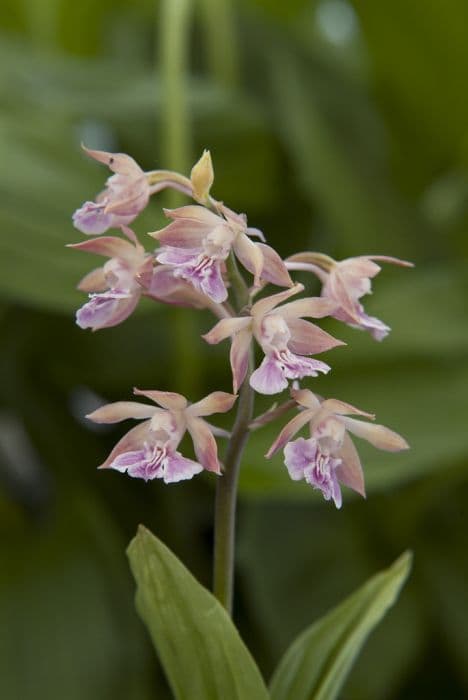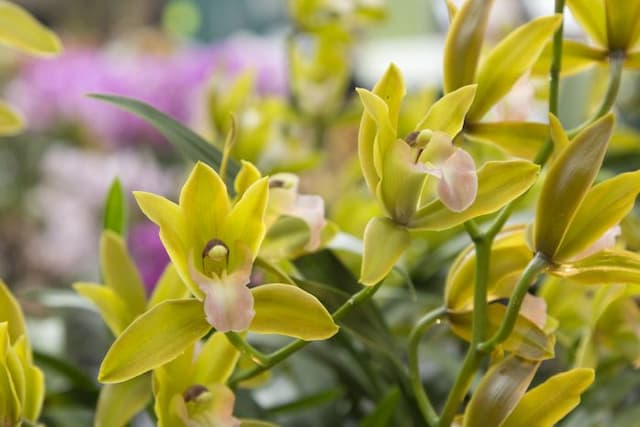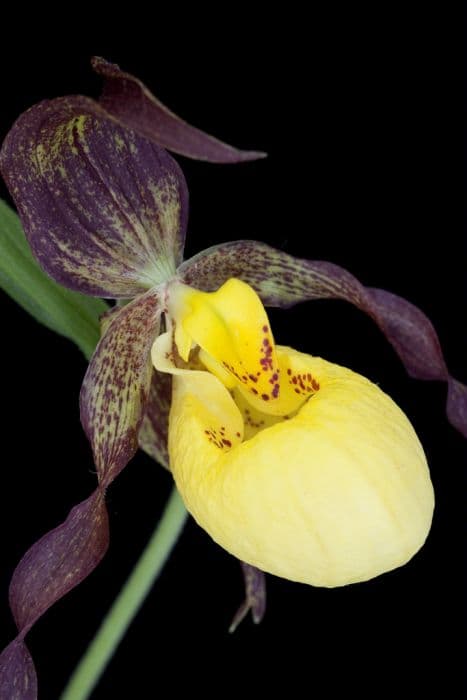Australian Rock Orchid Dendrobium × delicatum

ABOUT
Dendrobium × delicatum, commonly known as the delicate dendrobium, is an orchid hybrid notable for its eye-catching floral display. The blooms of this orchid are particularly striking, often presenting a range of colors from soft pinks to whites and sometimes with a subtle touch of lavender. Each flower gracefully spreads its petals and sepals, typically featuring a broad lip that is often marked or spotted with contrasting hues, adding to its allure. The delicate dendrobium exhibits a growth habit comprising upright to slightly arching stems that are clothed in alternating, lance-shaped leaves. These leaves are generally a vibrant green, offering a lush backdrop to the stunning blossoms. When in bloom, the flowers are typically arranged in clusters along the stem, creating a splendid show that can be both abundant and long-lasting. The overall appearance of the delicate dendrobium is one of elegance and exotic charm, with its impressive floral arrangement captivating and drawing admirers closer for a better look at the intricate patterning of its petals and the rich textures of its foliage. This plant has an enigmatic presence that can add a touch of the tropics to any setting in which it is placed.
About this plant
 Names
NamesFamily
Orchidaceae
Synonyms
Delicate Dendrobium, Miniature Rock Orchid, Delicate Rock Orchid, Rock Orchid Hybrid
Common names
Dendrobium × delicatum.
 Toxicity
ToxicityTo humans
Dendrobium × delicatum, commonly known as the Rock Orchid, is not known to be toxic to humans. Typically, orchids are considered safe and are not associated with severe toxicity if ingested. However, it is generally recommended to avoid eating ornamental plants as they are not intended for consumption and individual reactions to these plants can vary.
To pets
The Rock Orchid is not known to be toxic to pets. Like in humans, ingesting orchids like the Dendrobium × delicatum generally does not lead to serious illness in pets. Still, it is best to prevent pets from chewing on ornamental plants since they could potentially cause mild stomach upset or an individual may have a unique sensitivity.
 Characteristics
CharacteristicsLife cycle
Perennials
Foliage type
Evergreen
Color of leaves
Green
Flower color
Mixed
Height
1-2 feet (30-60 cm)
Spread
1-2 feet (30-60 cm)
Plant type
Orchid
Hardiness zones
9
Native area
Australia
Benefits
 General Benefits
General Benefits- Aesthetic Appeal: Dendrobium × delicatum, commonly known as the Rock Orchid, has showy flowers that enhance the beauty of gardens and indoor spaces.
- Ease of Cultivation: Rock Orchids are quite hardy and can be grown with relative ease by orchid enthusiasts and hobbyists.
- Long-Lasting Blooms: They are known for their long-lasting flowers, providing colour and interest for an extended period.
- Versatility in Landscaping: These orchids can be mounted on trees or rocks, or grown in pots, offering versatility in landscaping and garden design.
- Symbolism and Cultural Significance: Orchids like the Rock Orchid often symbolize love, luxury, and beauty, and can hold cultural significance in certain traditions.
- Habitat Support: When grown outdoors, they can provide nectar and serve as a food source for certain species of bees, butterflies, and other pollinators.
 Medical Properties
Medical PropertiesThis plant is not used for medical purposes.
 Air-purifying Qualities
Air-purifying QualitiesThis plant is not specifically known for air purifying qualities.
 Other Uses
Other Uses- Dendrobium × delicatum, commonly known as the Rock Orchid, can be used as a natural potting medium for other orchids due to its robust and thick roots which may provide support and nutrition.
- The long-lasting flowers of the Rock Orchid make it an excellent choice for cut floral arrangements, providing a touch of elegance and exoticism.
- The stems of the Rock Orchid can be used in basket weaving or as a component of natural crafts, where they add a unique texture and aesthetic.
- Due to its hardiness, Dendrobium × delicatum can be licensed for use in orchid conservation projects to reintroduce orchids to areas where they have become rare or extinct.
- The Rock Orchid's vibrant and colorful blossoms can be used as a natural dye for silks and fabrics, offering a range of hues from its various flower colorations.
- Enthusiasts may cultivate Dendrobium × delicatum as a hobby for competitive orchid shows, appreciating the plant's beauty and complexity.
- In landscape design, this orchid can be used to create tropical or subtropical themes, adding visual interest and biodiversity to gardens.
- Culinary experimentation with the Rock Orchid may include using the edible parts of the flower as an exotic garnish for high-end dishes, although consumption is rare and should be done with caution.
- The delicate structure of the Rock Orchid flowers can be used in the art of flower pressing, creating beautiful and intricate designs for crafts and decorations.
- Dendrobium × delicatum can serve as a living study subject for botany students and professionals looking to understand orchid morphologies, hybridization, and growth patterns.
Interesting Facts
 Feng Shui
Feng ShuiThe Dendrobium is not used in Feng Shui practice.
 Zodiac Sign Compitability
Zodiac Sign CompitabilityThe Dendrobium is not used in astrology practice.
 Plant Symbolism
Plant Symbolism- Resilience: Dendrobium × delicatum, commonly known as Rock Orchid, often grows on rocks and cliffs, showcasing its ability to thrive in tough conditions, symbolizing strength and resilience.
- Elegance and Beauty: The Rock Orchid's graceful appearance and beautiful flowers represent elegance and beauty, often associated with sophisticated aesthetics.
- Purity: Orchids are frequently associated with purity due to their delicate and pristine flowers, and the Rock Orchid is no exception.
 Water
WaterRock lily orchids, like Dendrobium × delicatum, should be watered generously during their growth period, typically once a week, with room temperature water until it runs freely from the pot's drainage holes. During winter or dormant periods, reduce watering to every other week or when the potting medium is dry to the touch. Ensure that the potting mix is almost dry before watering again, but do not let the plant dessicate completely. On average, this might equate to roughly 8 ounces of water per week during active growth and 8 ounces every two weeks when dormant.
 Light
LightRock lily orchids prefer bright, indirect light, making an east or south-facing window with a sheer curtain an ideal spot. They thrive in natural, diffused sunlight but should be protected from the harsh midday sun that can scorch their leaves. Ensure they receive adequate light without direct exposure to prevent potential damage.
 Temperature
TemperatureRock lily orchids do best in temperatures between 50 and 70 degrees Fahrenheit at night and between 70 and 85 degrees Fahrenheit during the day. These orchids can withstand a minimum nighttime temperature of 50 degrees Fahrenheit and a maximum temperature of around 90 degrees Fahrenheit for short periods. Ideally, they should be kept in stable conditions within these temperature ranges for optimal health.
 Pruning
PruningPruning Rock lily orchids is necessary to remove spent flower stems and encourage future blooming. Prune just above a node on the stem after the flowers have faded, usually in late winter or early spring. Pruning can be done annually, or as needed when flower spikes are no longer productive.
 Cleaning
CleaningAs needed
 Soil
SoilRock Lily (Dendrobium × delicatum) prefers well-draining potting medium like a mix of fine bark pieces, perlite, and sphagnum moss. The ideal soil pH is slightly acidic to neutral, ranging from 5.5 to 7.0.
 Repotting
RepottingRock Lily should be repotted every two to three years or when the potting mix breaks down and no longer drains properly.
 Humidity & Misting
Humidity & MistingRock Lily thrives in high humidity, ideally between 50-70%. Maintaining this humidity level is crucial for its growth.
 Suitable locations
Suitable locationsIndoor
Provide bright, indirect light and high humidity.
Outdoor
Partial shade, protect from intense afternoon sun.
Hardiness zone
9-11 USDA
 Life cycle
Life cycleDendrobium × delicatum, commonly known as the Delicate Dendrobium, commences its life cycle with seed germination, which is highly dependent on symbiosis with specific fungi for nutrients. The subsequent seedling stage involves the development of small protocorms that eventually give rise to shoots and roots. As the plant matures into the vegetative growth stage, it develops pseudobulbs and multiple strap-shaped leaves. During the flowering stage, which typically occurs in spring, it produces fragrant blooms ranging from white to yellow with purple or pink markings. After pollination, the flowers lead to the fruiting stage where capsules form and release numerous minute seeds, ready to be dispersed by wind, completing the cycle. This species can also engage in asexual reproduction through the division of pseudobulbs to establish new individuals.
 Propogation
PropogationPropogation time
Spring-Early Summer
Propogation: The most popular method for propagating a Dendrobium × delicatum, commonly known as a Rock Orchid, is through division. The best time to propagate this orchid is generally after it finishes flowering, which allows the new divisions time to establish themselves before entering their next growth cycle. To propagate by division, carefully remove the orchid from its pot and gently separate the pseudobulbs, ensuring that each division has at least three healthy pseudobulbs. Trim any damaged roots and plant the divisions into new pots with well-draining orchid medium. Keep the newly potted divisions in a warm, humid environment with bright, indirect light and water sparingly until new growth indicates that the plant has successfully established.









